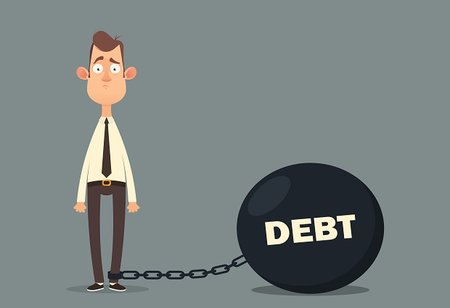How to Keep your Business Debt-Free?
By Tanuja A Akkannavar

Today’s business requires smart strategies and financial attention. The easy availability of loans and credit cards has decreased the financial complexities but has trapped the people into heavy debts. At times loans are necessary for establishing a company, in general, start-ups prefer taking loans to kick-start their business and pays back to the lender or the bank according to the income and rate of interests. The debts should be taken after focusing on all the possible ways to return it back because high debt amount may not only lose money but also increases the level of losing the business. Today, India Inc’s Corporate Debt is 56 percent of the total GDP, it is seen that the company’s interest expenses were more than their earnings; the interest rate has raised from 13 percent in 2007 to 43 percent in 2017. This increase in the rate of interest has risked the survival of the companies.
Financing a company is the most important ingredient in the development of a business. In order to pay the debts on time companies should not just have a stable business but should also have a constant source of income, this means for the long run, a company should plan and strategize not just to maintain their business but also to stay debt-free. There are many ways of keeping your business debt-free, some of them are listed below:
1. Planning –
The most important element in establishing and running a business successfully is ‘Planning’. Before and after taking debts a company should plan well about how the debts will be used to improve the business. The funding process from setting up a company until the stable run has to be planned precisely. The proper planning of the usage and paying debts can make the company free from the debts.
2. Target Debt –
Set up a business debt schedule, this makes it easy to pay the debts on time. The debts with the high rate of interest have to be called as ‘target debt’. Paying a high amount first can help the organization in the later stages to concentrate more on developing the products and services of a company. Prioritizing the debts by the level of interests makes it easy for the business to pay and keep the business free from the shackles of debts.
3. Increase in Source of Income –
As the income of the business increases, it helps the company in paying their debts easily. Regular improvisation of the products and services provided to the customers by the firm may increase the level of business and income of a company. Offering affordable price and discounts boosts the sales and this will automatically increase the income of a company. High income lessens the load of paying debts and increases the survival level of a company.
4. Monitor Your Finances –
Generally, monitoring finances on a regular base will help in ensuring the transactions that have taken place in a company. Recording the payments of your customers helps in knowing the amount received and yet to be covered by clients. The lenders or the bank closely look after the operations of the companies, therefore by monitoring company’s transactions and maintaining every detail might help a company easy return of the debts.
5. Cost Cutting-
The increase in sales is one part of the revenue, but if the expenses of the company are higher than its income it may result into facing loss and due in the debts may eventually lead in closing the company. The cost-cutting of the expenses might not save a company from debts but it can make a significant contribution to the purpose. The unused commodities or the space in the company can be given on rent, lease or can be sold to others. This extra amount can help a company in paying all the debts and loans.
6. Hire a Finance Consultant –
A finance consultant helps in financial decisions, he/she advices the company in not just managing the finances but also brings their expertise to the table when it comes to handling situations like debt management. He/she keeps the record of all the bills, loans and debts that has to be paid, how they can be paid and reminds the company on time which helps the company in paying them accordingly.
Today, most of the companies around the world, including large firms use debts to run and develop their business. However, Debt is always considered as a double-edged weapon in any business. It depends on how the debts are used by a company, paying them back and making a debt-free business or losing the company because of too many debts. It is essential that these debts are managed smartly for a long-lasting business.


